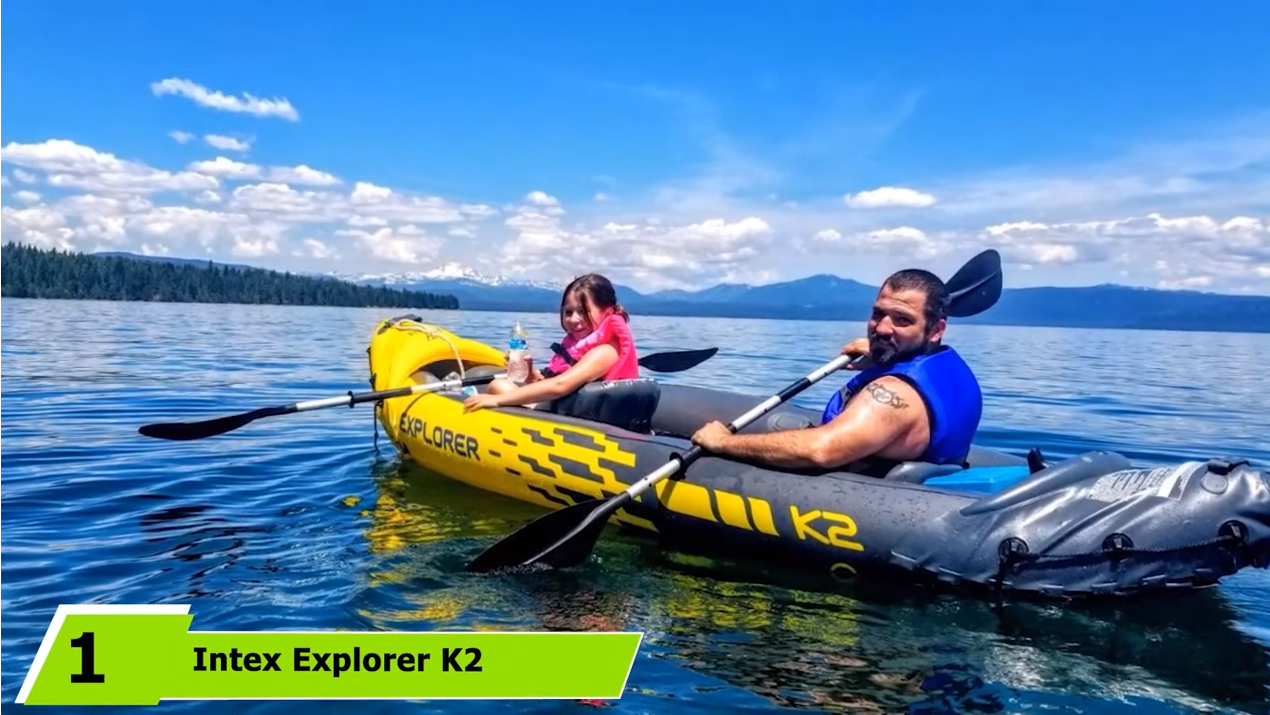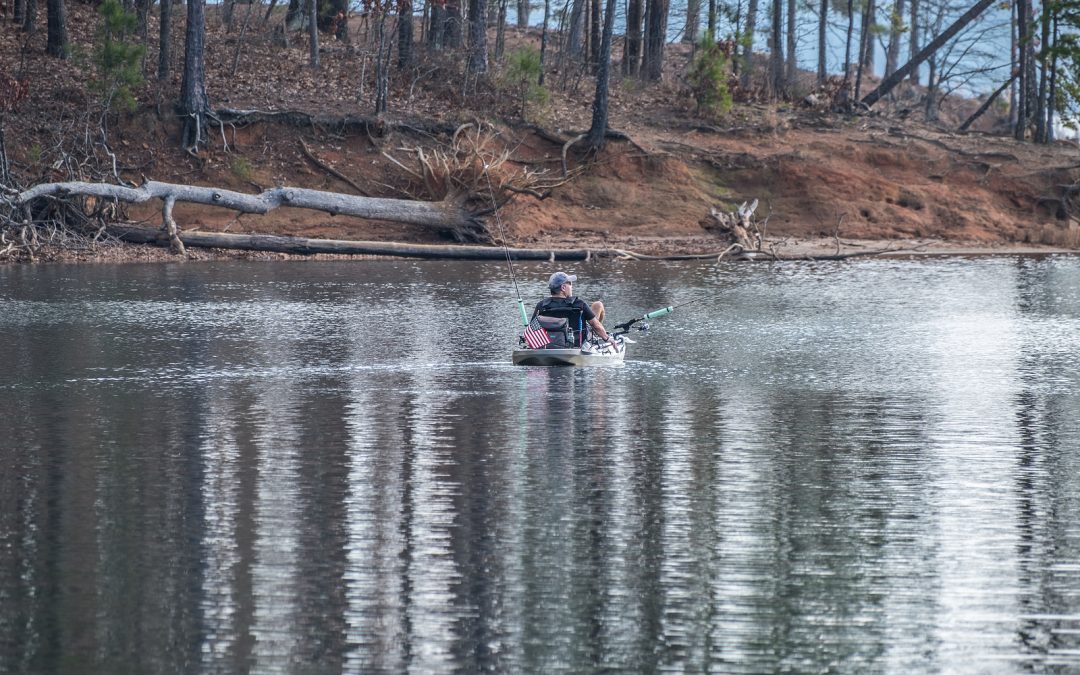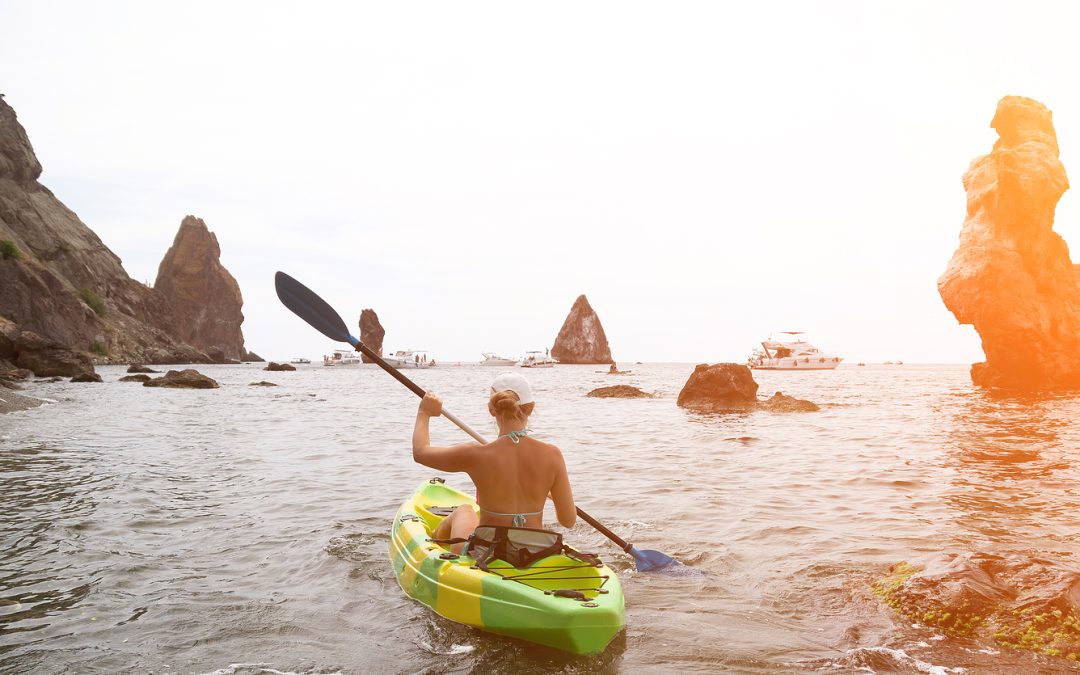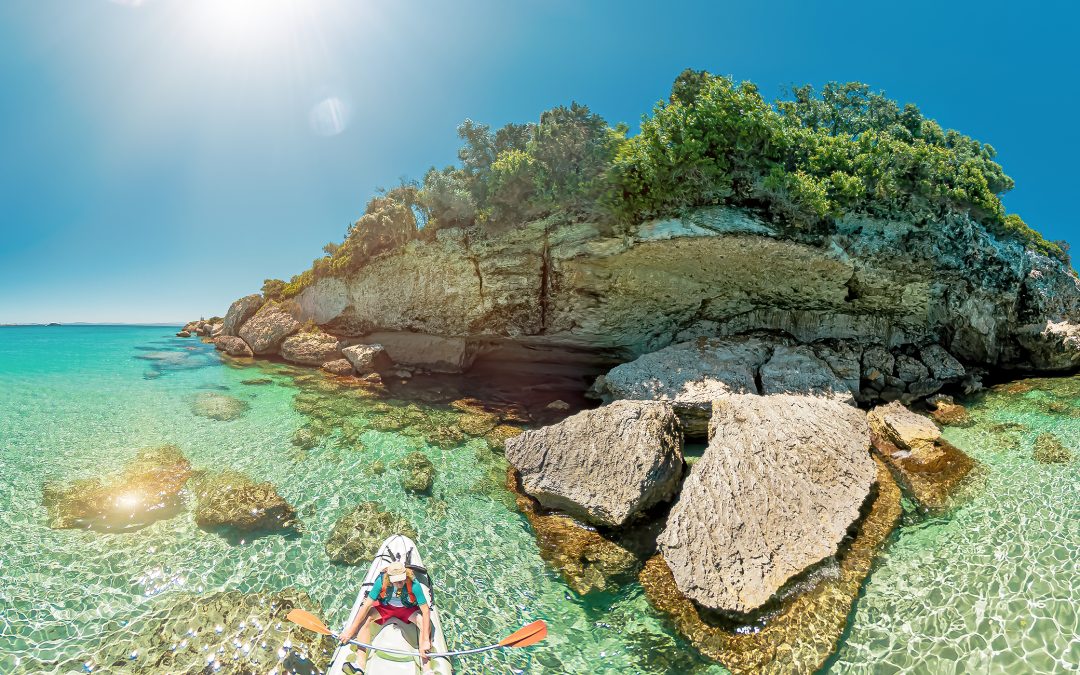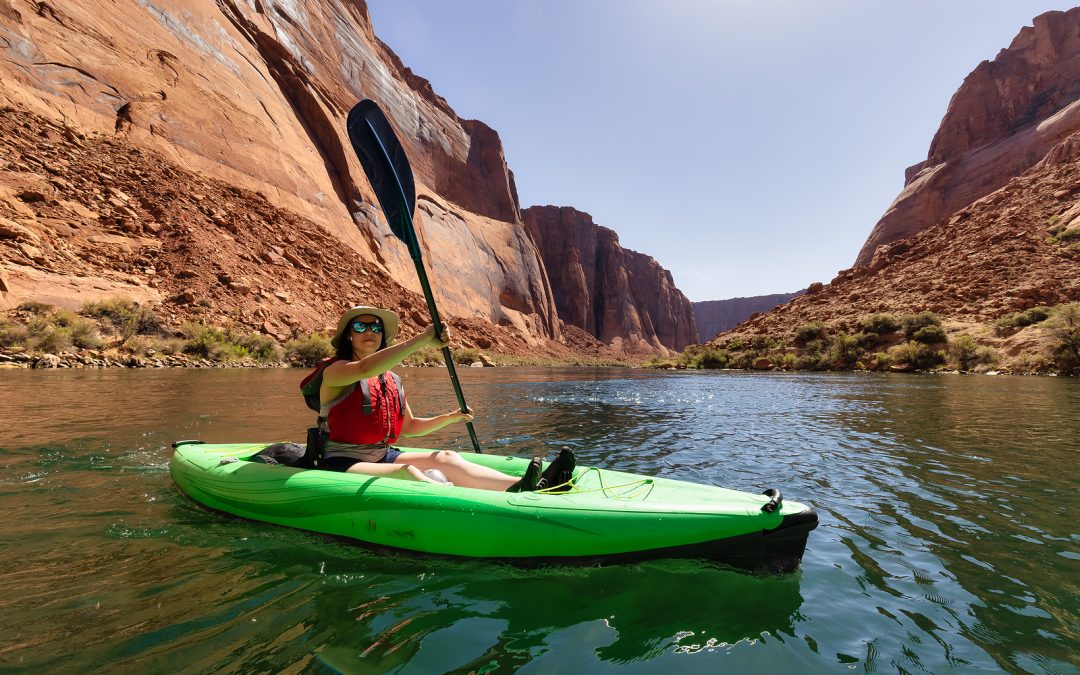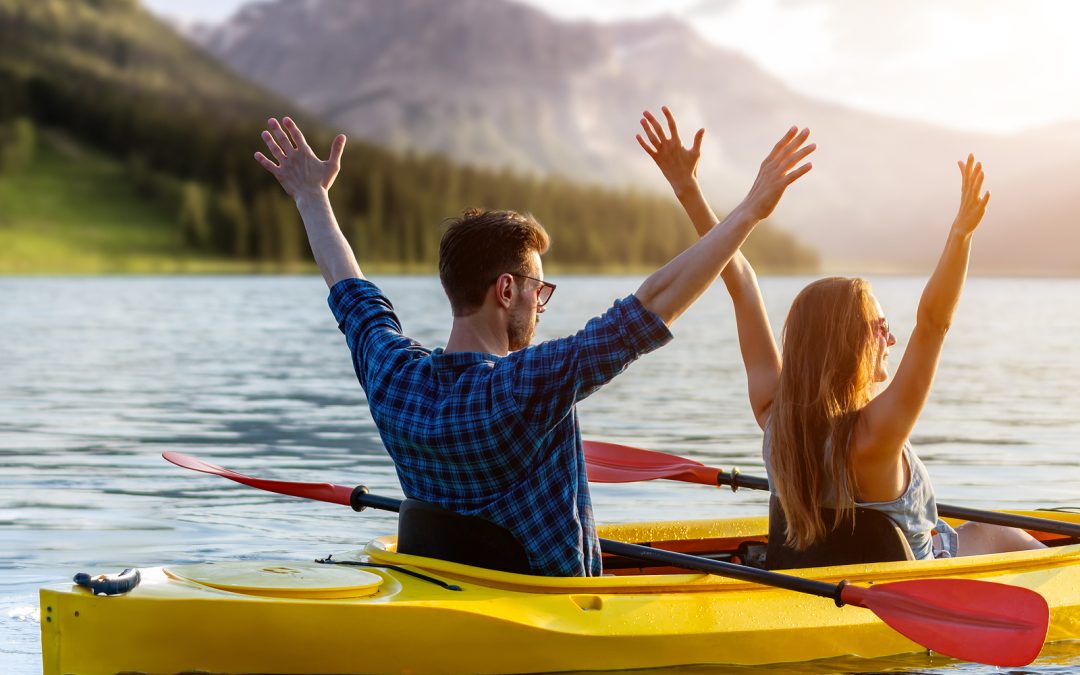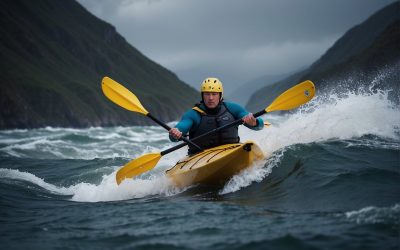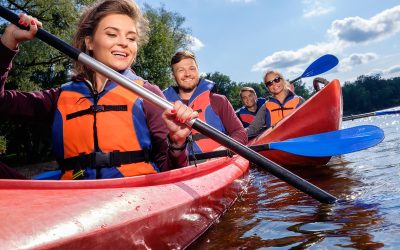Kayaking is a fun water sport that many people enjoy. It can be easy or hard depending on a few things.
Kayaking can be as simple or challenging as you want it to be, based on the water conditions and your goals.

For beginners, kayaking on calm lakes or slow rivers is pretty easy. You just need to learn some basic paddle strokes and how to balance in the boat.
With a little practice, most people can get the hang of it quickly.
If you want more of a challenge, you can try kayaking in rougher waters or going on longer trips. This takes more skill and strength. But don’t worry – you can start small and work your way up as you get better.
Key Takeaways
- Kayaking difficulty varies based on water conditions and personal goals
- Beginners can start on calm waters to learn basic skills
- Safety gear and proper planning are important for an enjoyable kayaking experience
Kayaking Fundamentals
Kayaking is an enjoyable water sport that combines outdoor adventure with physical exercise. Learning the basics of kayaking, understanding different kayak types, and having the right gear are key to a safe and fun experience on the water.
Understanding Kayaking
Kayaking involves paddling a small boat with a double-bladed paddle. The paddler sits in a seat with their legs extended in front of them.
Kayaks are designed to be stable and maneuverable in various water conditions.
Proper paddling technique is crucial for efficiency and safety. The basic forward stroke involves dipping one blade into the water near your feet and pulling it back alongside the kayak. Alternate sides to move straight ahead.
Balance is important in kayaking. Sit up straight with your back against the seat backrest. Keep your lower body relaxed and your knees slightly bent against the sides of the cockpit.
Kayaking can be easy or challenging depending on the conditions and your skill level. Beginners should start on calm, flat water before progressing to more difficult environments.
Types of Kayaks
There are several types of kayaks, each designed for specific uses:
- Recreational kayaks: Stable and easy to use, ideal for beginners on calm lakes and slow-moving rivers.
- Touring kayaks: Longer and narrower, built for extended trips and rougher water conditions.
- Whitewater kayaks: Short and agile, designed for navigating rapids and fast-moving rivers.
- Sit-on-top kayaks: Open design with no enclosed cockpit, great for warm weather and easy entry/exit.
- Inflatable kayaks: Portable and easy to store, suitable for casual paddling on calm waters.
Each type has its pros and cons. Choose based on your intended use, skill level, and the water conditions you’ll encounter most often.
Essential Gear and Equipment
Proper gear is crucial for safety and comfort while kayaking. Here’s a list of essential items:
- Personal Flotation Device (PFD): Always wear a well-fitting life jacket.
- Paddle: Choose the right size and material for your kayaking style.
- Spray skirt: Keeps water out of the cockpit in rough conditions.
- Helmet: Necessary for whitewater kayaking or rocky areas.
- Appropriate clothing: Quick-drying synthetic materials, avoid cotton.
Sun protection is important, even on cloudy days. Wear sunscreen, a hat, and sunglasses. Bring water and snacks for longer trips.
For safety, carry a whistle, flashlight, and first-aid kit. A bilge pump or sponge can help remove water from your kayak if needed.
Physical Demand and Skill Levels

Kayaking involves varying levels of physical exertion and technical ability. The demands change based on factors like water conditions, kayak type, and paddling duration.
Physical Fitness Requirements
Kayaking provides a low-impact workout that can be adjusted to different fitness levels. It mainly engages the upper body, core, and back muscles.
Beginners can start with short, leisurely paddles on calm waters. This requires minimal fitness and is suitable for most people.
For longer trips or rougher waters, kayakers need more stamina and strength. Good cardiovascular fitness helps maintain energy over extended periods.
Upper body strength is crucial for efficient paddling and maneuvering the kayak.
Flexibility and balance also play important roles. Kayakers sit in a confined space and need to twist their torso while paddling. Good balance helps prevent capsizing, especially in choppy conditions.
Skill Levels for Kayaking
Kayaking skills range from beginner to expert. Here’s a basic breakdown:
- Beginner: Can paddle on calm, flat water and perform basic strokes
- Intermediate: Comfortable in light waves, can navigate obstacles
- Advanced: Handles rough water, performs rolls, and tackles rapids
- Expert: Masters challenging whitewater and ocean conditions
Beginners often start with recreational kayaking on calm lakes or slow-moving rivers. As skills improve, kayakers can progress to more challenging environments like faster rivers or coastal waters.
Skill development involves learning proper paddling techniques, understanding water dynamics, and mastering safety procedures. Regular practice and gradual exposure to varied conditions help kayakers advance their abilities.
Developing Paddling Techniques
Proper paddling technique is essential for efficient kayaking and injury prevention. Key techniques include:
- Forward stroke: The main propulsion method
- Reverse stroke: For stopping or moving backward
- Sweep stroke: Used for turning the kayak
- Draw stroke: Helps move the kayak sideways
Beginners should focus on mastering these basic strokes. Proper form involves engaging the core, using a relaxed grip, and rotating the torso.
Advanced techniques like bracing and rolling help kayakers handle rougher conditions. These skills require practice and often benefit from professional instruction.
Developing good paddling technique takes time and patience. Regular practice in various conditions helps refine skills and build muscle memory. Many kayakers find joining clubs or taking lessons accelerates their progress.
Safety Considerations
Kayaking safety involves being prepared for environmental factors, using proper personal gear, and knowing how to handle potential hazards. Taking precautions helps ensure an enjoyable experience on the water.
Environmental Factors
Weather and water conditions play a big role in kayaking safety. Check weather forecasts before heading out. Look for wind speed, temperature, and chance of storms.
Water temperature is also key. Cold water can be dangerous even on warm days.
Pay attention to water currents and tides when kayaking in rivers or oceans. Strong currents can quickly sweep kayakers off course. Tides can leave kayakers stranded if not timed properly.
Be aware of local wildlife and plants. Some animals may be aggressive if approached too closely. Certain plants can cause skin irritation if touched.
Personal Safety Gear
Wearing the right gear is crucial for kayak safety. A properly fitting life jacket is a must. It should be snug but allow full arm movement.
Other important items include:
- Whistle for signaling
- Dry bag for electronics and spare clothes
- First aid kit
- Sun protection (hat, sunglasses, sunscreen)
- Water and snacks
For cold water, wear a wetsuit or drysuit. This helps prevent hypothermia if you capsize.
Kayaking Hazards
Capsizing is a common kayaking hazard. Learn how to right your kayak and re-enter it in deep water. Practice these skills in a safe area before heading out.
Obstacles like rocks, logs, and low-hanging branches can flip a kayak. Stay alert and steer clear of these dangers.
In moving water, watch for hydraulics or “holes” that can trap a kayak.
Fatigue is another risk. Don’t overestimate your strength or endurance. Plan trips that match your skill level and fitness. Take breaks as needed.
Dehydration and sunburn are easy to overlook. Drink plenty of water and reapply sunscreen often, even on cloudy days.
Planning Your Kayaking Trip
Good planning is key to a fun and safe kayaking trip. The right location, weather, and pacing can make a big difference. Let’s look at how to set yourself up for success.
Choosing the Right Location
Pick a spot that fits your skill level. For beginners, calm waters are best. Look for lakes, slow-moving rivers, or sheltered bays. These areas let you focus on basic skills without strong currents.
Check if you need permits or passes. Some places have rules about where you can kayak. Make sure you know them before you go.
Think about facilities too. Is there a good launch spot? Are there bathrooms nearby? These things can make your trip more comfortable.
Consider the scenery. Pretty views can make your trip more fun. But don’t pick a spot that’s too hard just because it looks nice.
Evaluating Weather Conditions
Weather plays a big role in kayaking. Check the forecast a few days before and on the day of your trip. Look for:
- Wind speed and direction
- Chance of rain or storms
- Temperature (air and water)
- Visibility
Calm, clear days are best for new kayakers. Strong winds can make paddling hard and dangerous. If there’s a chance of storms, it’s better to reschedule.
Water temperature matters too. If it’s cold, you’ll need special gear to stay safe. Always dress for the water temp, not the air temp.
Trip Duration and Pacing
For your first few trips, keep things short and easy. A 2-3 hour trip is plenty. This gives you time to get a feel for kayaking without getting too tired.
Plan breaks into your trip. Every 30-60 minutes, stop to rest, drink water, and stretch. This helps prevent fatigue and keeps you comfortable.
Set a reasonable pace. Most people can paddle about 2-3 miles per hour in calm water. But don’t push yourself too hard. It’s better to go slow and steady than to wear yourself out.
Always leave some energy for the trip back. Remember, you’ll need to paddle to your starting point unless you’ve arranged a pickup.
Practical Tips for Beginners
New kayakers can boost their skills and confidence with a few key strategies. These tips will help beginners get started safely and enjoy their time on the water.
Starting with Guided Tours
Guided kayak tours offer a great way for beginners to learn the basics. Professional instructors teach proper techniques and safety rules. They also provide all the needed gear.
Tours often take place on calm waters, perfect for learning. Beginners can focus on paddling without worrying about navigation or equipment.
Group tours create a fun, social atmosphere. Paddlers can meet others who share their interest in kayaking. This can lead to future kayaking buddies and more opportunities to practice.
Basic Strokes and Maneuvers
Learning basic kayak strokes is crucial for control and efficiency on the water.
The forward stroke is the most important, used to move the kayak ahead. The sweep stroke turns the kayak, while the reverse stroke helps with stopping and backing up.
Practicing these strokes in calm water builds muscle memory. Start with short sessions to avoid fatigue. Focus on proper form rather than speed or power.
Mastering the wet exit is a key safety skill. This involves safely getting out of the kayak if it flips over. Practice this technique in shallow water with a trained instructor.
Building Confidence on the Water
Confidence grows with practice and positive experiences.
Start in calm, shallow waters where you feel safe. Gradually move to more challenging conditions as your skills improve.
Set small, achievable goals for each outing. This might be paddling a certain distance or trying a new stroke.
Celebrate these wins to boost your confidence.
Stay relaxed and focused. Tension makes balancing harder and paddling less efficient.
Take deep breaths and enjoy the scenery if you feel nervous.
Paddle with more experienced kayakers when possible.
They can offer tips and support. Just make sure to stay within your comfort zone and skill level.
Improving Your Kayaking Experience

Kayaking skills grow with practice and dedication.
Mastering advanced techniques, building strength, and connecting with other paddlers can enhance your time on the water.
Advanced Paddling Techniques
To boost your kayaking skills, try new strokes.
The sculling draw helps move sideways smoothly. Practice the bow draw to turn quickly in tight spots.
Work on your forward stroke. Keep your torso rotated and arms straight. This saves energy on long trips.
Perfecting your technique leads to more fun and less fatigue.
Edging your kayak improves control. Lean slightly to one side to make sharper turns. Start in calm water before trying rougher conditions.
Learn to read water currents. Look for V-shaped patterns pointing downstream.
Avoid obstacles by planning your route ahead of time.
Fitness and Endurance Training
Building strength helps kayakers paddle longer.
Focus on core exercises like planks and Russian twists. Strong abs and back muscles power your strokes.
Cardio workouts boost stamina for long trips. Try running, swimming, or cycling.
Aim for 30 minutes of exercise, 3-4 times a week.
Practice kayaking regularly to build specific muscle memory.
Start with short trips and slowly increase distance. This helps prevent injury and improves form.
Flexibility matters too.
Stretch before and after paddling. Pay extra attention to shoulders, back, and hips.
Yoga can be great for kayakers.
Joining a Kayaking Community
Find local kayaking clubs or groups. They often offer trips for different skill levels.
Group paddles are fun and safer than going alone.
Experienced kayakers can share tips and tricks. Ask questions and learn from their stories.
Many clubs also provide safety courses and rescue training.
Online forums connect paddlers worldwide.
Share photos, ask for advice, or plan trips. Social media groups are great for staying up-to-date on local events.
Volunteer for river cleanups or conservation efforts. This helps protect waterways and builds connections with fellow nature lovers.
Environmental Stewardship

Kayaking offers a unique opportunity to connect with nature while promoting conservation. Responsible paddlers can make a positive impact through mindful practices and respect for the environment.
Respecting Wildlife
Kayakers often encounter wildlife in their natural habitats.
It’s crucial to maintain a safe distance from animals to avoid disturbing their routines. Keep noise levels low and avoid sudden movements that might startle creatures.
Use binoculars for a closer look instead of approaching animals directly. This helps protect nesting sites and feeding areas.
Be especially careful during breeding seasons when animals are more sensitive to disturbances.
Never feed wildlife, as this can alter their natural behaviors and diets. If you spot injured animals, contact local wildlife authorities rather than attempting to help yourself.
Leave No Trace Principles
The Leave No Trace philosophy is essential for minimizing kayaking’s environmental impact.
Plan ahead to reduce waste and pack out everything you bring in. Use designated launch sites and campsites to avoid damaging sensitive areas.
Dispose of waste properly, including human waste. Use biodegradable soap for cleaning, and do so at least 200 feet away from water sources.
Avoid removing natural objects like rocks, plants, or artifacts.
Respect fire regulations and use established fire rings when allowed. Fully extinguish fires and scatter cool ashes.
Stay on marked trails when portaging to prevent erosion and protect vegetation.
Sustainable Kayaking Practices
Choose eco-friendly kayaking gear made from sustainable materials.
Opt for kayaks made from recycled plastics or natural fibers when possible. Use biodegradable lubricants for your kayak’s moving parts.
Clean your kayak thoroughly between trips to different water bodies. This prevents the spread of invasive species that can harm local ecosystems.
Use environmentally friendly cleaning products for this task.
Support local conservation efforts by participating in clean-up events or donating to organizations that protect waterways.
Consider joining a kayaking club that promotes environmental stewardship and educates members on sustainable practices.
The Social Aspect of Kayaking

Kayaking offers many opportunities to connect with others and build relationships. It brings people together through shared adventures and experiences on the water.
Organizing Group Outings
Planning kayak trips with friends is a fun way to spend time together.
Pick a date and location that works for everyone. Consider experience levels when choosing a route.
Bring enough kayaks, paddles, and life jackets for the group. Pack snacks and water to share during breaks.
Designate a trip leader to guide the group. This person should know the route well. They can help keep everyone safe and on track.
Set a meeting spot and time in case people get separated.
Group kayaking builds teamwork skills.
Paddlers learn to communicate and work together. They may need to help each other launch boats or navigate tricky areas.
These shared challenges create lasting bonds.
Family Kayaking Adventures
Kayaking is a great family activity.
It gets everyone outdoors and active together.
Kids as young as 5 or 6 can start in tandem kayaks with an adult. Older children may be ready for their own boats.
Choose calm waters for beginners. Lakes and slow-moving rivers work well.
Bring along games or nature guides to keep kids engaged. Take frequent breaks on shore to explore or have snacks.
Family kayaking teaches important skills.
Kids learn water safety and paddling techniques. They gain confidence as they improve.
Parents can bond with children through shared discoveries on the water.
Kayaking Clubs and Meetups
Joining a kayak club is a good way to meet other paddlers.
Clubs often organize regular outings for members. They may offer classes to improve skills.
Some host social events like potlucks or photo-sharing nights.
Look for clubs through local outdoor stores or parks. Many have Facebook groups or websites with event calendars. Meetup.com is another place to find kayaking groups.
Kayak racing adds a competitive social aspect.
Sprint races test speed over short distances. Marathon races cover longer routes.
These events bring paddlers together to challenge themselves and cheer each other on.
Frequently Asked Questions

Kayaking has safety considerations, physical demands, and learning curves. It offers health benefits but requires proper preparation and precautions.
What should beginners know before trying kayaking?
Beginners should dress for getting wet and wear a life jacket.
They need to learn basic paddling techniques and safety rules.
Choosing a stable, beginner-friendly kayak is important. Starting on calm water allows new kayakers to build skills gradually.
What are the common risks associated with kayaking?
Capsizing is a common risk in kayaking. Other hazards include sunburn, dehydration, and hypothermia in cold water.
Collisions with rocks or other obstacles can occur, especially in moving water. Weather changes can create dangerous conditions quickly.
How does the difficulty of kayaking compare to canoeing?
Canoeing is generally harder than kayaking.
Canoes are heavier and use single-blade paddles, making them trickier to maneuver.
Kayaks are usually more stable and easier to control for beginners. Their double-blade paddles allow for more efficient strokes.
What are the physical benefits of taking up kayaking?
Kayaking provides a full-body workout. It strengthens arm, shoulder, back, and core muscles.
Regular kayaking improves cardiovascular fitness and endurance. It also enhances balance and coordination skills.
For non-swimmers, what precautions should be taken when kayaking?
Non-swimmers must always wear a properly fitted life jacket.
They should stick to calm, shallow waters.
Kayaking with a buddy is crucial for safety. Learning self-rescue techniques is important, even for non-swimmers.
How long typically does it take to become proficient in kayaking?
Basic kayaking skills can be learned in a few hours.
Proficiency depends on practice frequency and water conditions.
Taking courses and joining paddling clubs can speed up skill development.
Most people become comfortable after 5-10 outings in various conditions.


